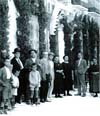THE END OF SPANISH MORTGAGE SYSTEM BASED ON PERPETUAL RENTS: A FAR LASTING AGONY? (1705-1861)
Supporting Agencies
- proyecto BXXX2000-0534- C03-02
- Programa Nacional de Promoción General del Conocimiento del Ministerio de Ciencia y Tecnología
Abstract
The last reduction of the legal interest rate for the perpetual mortgage rents, from 5 to 3% established in 1705 or 1750 in the several kingdoms of the Spanish monarchy, did not entail an ultimate crisis for a mortgage system where the Catholic Church played a central role. Similarly to other previous reductions, it adjusted the interest rate to the diminishing profits in renting the land due to the strong increase in its price. The mortgage system was blocked later on, between 1790 and 1833, as a result of the "strike" against tithes, land rents and perpetual mortgage rents that peasants, whether tenants or copyholders, started when the agrarian growth of the eighteenth century became incompatible with the institutional framework of the Ancien Régime. After the swings of liberal revolutions and civil wars, the way to transform the old mortgage system into a new liberal one was eventfully open with the redemptions of perpetual mortgage rents established en 1855-56, the signature of the agreement between the Spanish liberal government and the Pope in 1860, and the new mortgage law of 1861.
Downloads
-
Abstract276
-
PDF (Español (España))215

The published works by this Journal are subject to the following terms:
1. The Publication Service of the University of Murcia (the Editor) owns the copyright of its publications. It promotes and allows its use under the indicated licence in Section 2.
© Servicio de Publicaciones, Universidad de Murcia, 2011
2. Papers are digitally published under the licence Creative Commons Reconocimiento-NoComercial-SinObraDerivada 3.0 España (legal text). They can be copied, used, disseminated, transferred and publically presented if: i) the author is quoted, as well as the original source of publication (Journal, editorial and URL); ii) they are not used for commercial purposes; iii) the licence of use is mentioned.
3. Auto-file Conditions. It is allowed and authors are encouraged to digitally disseminate their pre-print versions (versions prior to review) and/or post-print (reviewed version accepted for its publication) since it promotes its early diffusion and the corresponding increase of quotes and scope within the academic community. RoMEO Colour: green.

